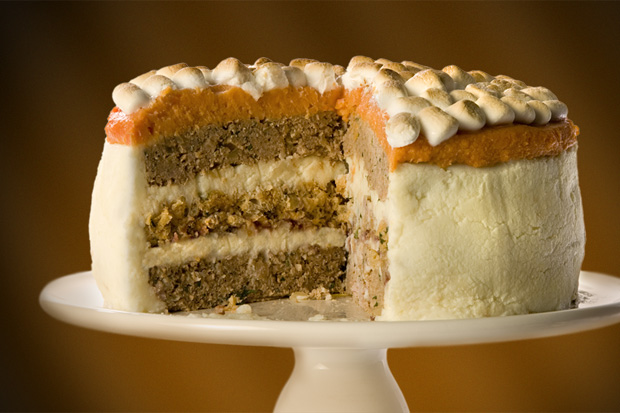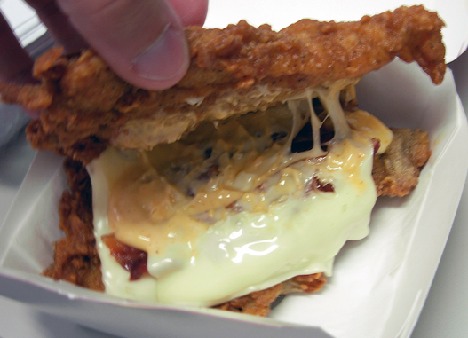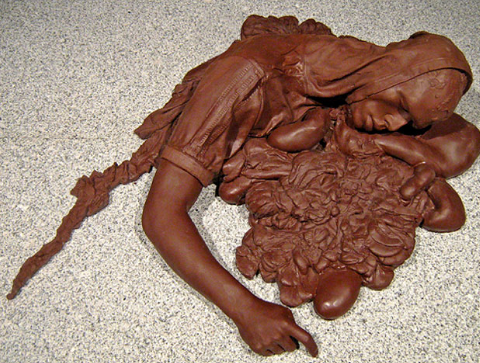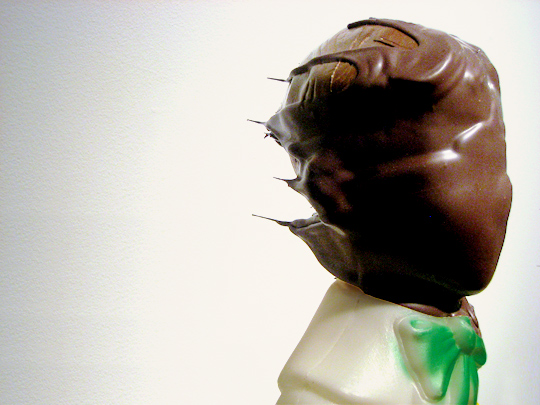
Image (and recipe): Chow
When I discovered the true nature of the image above, which appeared to be a delicious carrot cake, I felt an unexpected disgust. Full disclosure: I am a vegetarian with a sweet tooth, so the fact that what appeared to be cake was, in fact, ground turkey was pretty gross to me. However, I imagine that someone who had been dooped might initially feel the same way, before, perhaps, shifting into delight that an entire Thanksgiving dinner had been contained in one slice, and so masterfully. My reaction, however extreme, made me think about food as a medium, the arguments it makes, and the arguments we make about it.
An interesting example is the KFC Double Down, which received criticism less because of its actual nutritional content (not as bad as you think, especially compared to other fast food sandwiches) but because of its iconic representation of American overconsumption, particularly of animal protein and fat. The Double Down, which Mark Morford labels "a horrible crapbucket of chyme," represents everything from the perverse side of low-carb dieting to the horrors of American meat production. It makes an apparently apocalyptic argument--but, also, an argument for deliciousness, at least in its professional photos. Customer action shots are sometimes less savory, at least for some audiences:

Image: Treehugger
Obviously, an argument made with or by food has appeals that function differently; an audience could be more physically moved by appeals to their hunger (or desire to taste something good) or by disgust. The Thanksgiving cake also made me think of Stephen J. Shanabrook, who uses chocolate to create representations of dead bodies, many based on actual corpses.

Image: Stephen J. Shanabrook
Shanabrook's "Waterboarding" pieces are somewhat more subtle, but potentially more haunting:

Image: Stephen J. Shanabrook, via Eat Me Daily
While Shanabrook's work is obviously at a different end of the spectrum from the Thanksgiving cake, I think it is productive to ask, in all these cases, what arguments do these foodstuffs make? Presumably, the mimicry in the Thanksgiving cake makes a definitional argument (I am a cake) and then expands the eater's expectations of what being a cake means. The Double Down reads in different ways, but it (or, rather, its creators) has often been accused of unfair persuasion, abusing for profit humans' natural inclination toward fatty foods. Shanabrook's pieces take the fragility and beauty of chocolate and shape it into the grotesque and the shameful; however, the ephemerality of chocolate seems consistent with the rapid decomposition of a corpse or the unseen impact of "clean torture" like waterboarding.
Discussion of creations like these could be useful in a classroom for expanding students' attitudes about medium. Since we have obvious expectations of what a cake, a sandwich, and a chocolate sculpture look like, all of these creations use medium to frustrate our expectations in a way that might not be immediately clear in other kinds of texts.




Recent comments
2 years 29 weeks ago
2 years 44 weeks ago
2 years 44 weeks ago
2 years 50 weeks ago
3 years 4 weeks ago
3 years 4 weeks ago
3 years 4 weeks ago
3 years 6 weeks ago
3 years 6 weeks ago
3 years 6 weeks ago